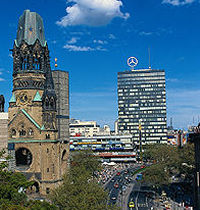
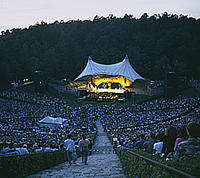

Charlottenburg – Schöneberg – Tiergarten – Wilmersdorf
 |
 |
 |
![]() More than its location
made Charlottenburg West Berlin's centre in the times of the city's
separation. Zoo station, ICC fairground and a part of the Kurfürstendamm
(shared by Wilmersdorf
and Charlottenburg) belongs as well to the district as Gedächtniskirche church
or Olympic stadion. One of the places where the metropolitan life is to be
experienced the most intensely is on the Kurfürstendamm between Breitscheid-
and Joachimstaler Platz squares, where presently the famous Kranzler-Eck
is being restored. Focus of the Breitscheidplatz is the often
photographed Kaiser-Wilhelm-Gedächtniskirche (emperor Wilhelm memorial
church) which after being smashed in 1943 got seconded by a new building in the
1950s and remained conserved as a ruin. The Europa Center, established in
the 1960s as first German shopping mall with more than hundred stores, also
accommodates the tourist information. Centre of the Kantstraße, heading
from Breitscheidplatz to the West like the Kudamm, is the Savignyplatz
whose cafes and restaurants have been popular meeting points for artists and
writers since the 1920s. Bismarckstraße / Kaiserdamm leads from Ernst-Reuter-Platz
square, the Technical University's site and one of the city's junctions,
to Theodor-Heuss-Platz. Between Kudamm and Theodor-Heuss-Platz the fair and
congress centre ICC, a vast fairground of international rank, marks the
city's western end. The Funkturm (radio tower), reminding of a scaled
down Eiffel tower, is a favoured look-out. The Olympic stadion and the
neighbouring Maifeld field where the last offshoots of the Grunewald are
to be sensed between the mansions, are designed in monumental Nazi architecture.
The home stadion of first league soccer team Hertha BSC will set the scene for
the worldcup 2006. On the other end of the Maifeld is the Waldbühne
stage located, a popular location for concerts and big events in the green. One
of Charlottenburg's most beautiful areas is the district's Northeast, coined by castle
Charlottenburg, a splendid rococo residence with a lovely park
inviting the visitor to tarry. The Schlossstraße, heading for the castle, isn't
only worth seeing due to the exclusive residences but also due to its museums:
the Bröhanmuseum with design, fine arts and jewellery from the turn of
the century, the elegant Stüler building, accommodating the Berggruen
collection with paintings by Picasso, Klee and van Gogh, and the Egyptian
Museum, whose unique Nofretete's bust has become one of the city's
landmarks, are here side by side.
More than its location
made Charlottenburg West Berlin's centre in the times of the city's
separation. Zoo station, ICC fairground and a part of the Kurfürstendamm
(shared by Wilmersdorf
and Charlottenburg) belongs as well to the district as Gedächtniskirche church
or Olympic stadion. One of the places where the metropolitan life is to be
experienced the most intensely is on the Kurfürstendamm between Breitscheid-
and Joachimstaler Platz squares, where presently the famous Kranzler-Eck
is being restored. Focus of the Breitscheidplatz is the often
photographed Kaiser-Wilhelm-Gedächtniskirche (emperor Wilhelm memorial
church) which after being smashed in 1943 got seconded by a new building in the
1950s and remained conserved as a ruin. The Europa Center, established in
the 1960s as first German shopping mall with more than hundred stores, also
accommodates the tourist information. Centre of the Kantstraße, heading
from Breitscheidplatz to the West like the Kudamm, is the Savignyplatz
whose cafes and restaurants have been popular meeting points for artists and
writers since the 1920s. Bismarckstraße / Kaiserdamm leads from Ernst-Reuter-Platz
square, the Technical University's site and one of the city's junctions,
to Theodor-Heuss-Platz. Between Kudamm and Theodor-Heuss-Platz the fair and
congress centre ICC, a vast fairground of international rank, marks the
city's western end. The Funkturm (radio tower), reminding of a scaled
down Eiffel tower, is a favoured look-out. The Olympic stadion and the
neighbouring Maifeld field where the last offshoots of the Grunewald are
to be sensed between the mansions, are designed in monumental Nazi architecture.
The home stadion of first league soccer team Hertha BSC will set the scene for
the worldcup 2006. On the other end of the Maifeld is the Waldbühne
stage located, a popular location for concerts and big events in the green. One
of Charlottenburg's most beautiful areas is the district's Northeast, coined by castle
Charlottenburg, a splendid rococo residence with a lovely park
inviting the visitor to tarry. The Schlossstraße, heading for the castle, isn't
only worth seeing due to the exclusive residences but also due to its museums:
the Bröhanmuseum with design, fine arts and jewellery from the turn of
the century, the elegant Stüler building, accommodating the Berggruen
collection with paintings by Picasso, Klee and van Gogh, and the Egyptian
Museum, whose unique Nofretete's bust has become one of the city's
landmarks, are here side by side.
The city-train axis S3, S5, S7 and S9 traverses Charlottenburg from Zoo station to fairground, U2, U9 and S4 condense the public transport net. Still, Zoo station is Berlin's most important long-distance station, Tegel airport neighbours the district in the North.
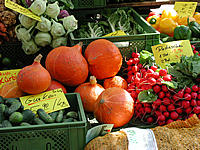 |
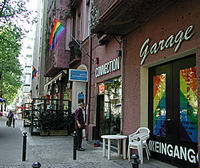 |
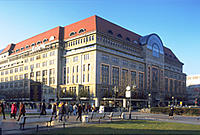 |
![]() Not only in a geographical
respect, Schöneberg lies between scene district Kreuzberg
and bourgeois, chic Wilmersdorf.
Its stylish pubs, cafes and restaurants make the district a vital as well as
dignified clubbing quarter. To experience Schöneberg, you best visit Winterfeldmarkt
market on a weekend where you can buy almost anything from vegetables over
cloths to jewellery and subsequently visit one of the numerous cafes in the
surroundings. Fuggerstraße is centre of a well known gay and lesbian scene
which enriches the city life with eccentric bars and events. If you prefer a
quieter place you should visit Viktoria-Luise-Platz square or Friedenau's
mansions, a quarter in Schöneberg's South. Especially in the 60s, literature
(history) was written here by authors like Grass, Enzensberger, Frisch and
Johnson, and published by leading houses like S. Fischer, Rowohlt or
Langenscheidt. Bayrisches Viertel neighbouring Wilmersdorf
reminds of Jew prosecution with signs from the time of the Third Reich. Not far
away, John F. Kennedy won the hearts of the West Berliners, who have just been
enclosed by the Berlin Wall, with his "Ich bin ein Berliner" (I am a
Berliner). Schöneberg town hall, the location of this famous speech in
1963, was the site of West Berlin's government; still, the Freiheitsglocke
(freedom bell) rings every noon. The cemetary in the Stubenrauchstraße keeps
the memory of perhaps the most famous daughter of Berlin: the great diva Marlene
Dietrich, born 1901 in Schöneberg. On the Tauentzienstraße, the eastern
prolongation of Kurfürstendamm boulevard, the Kaufhaus des Westens (KaDeWe),
the continent's biggest department store, invites for strolling and shopping.
Not only in a geographical
respect, Schöneberg lies between scene district Kreuzberg
and bourgeois, chic Wilmersdorf.
Its stylish pubs, cafes and restaurants make the district a vital as well as
dignified clubbing quarter. To experience Schöneberg, you best visit Winterfeldmarkt
market on a weekend where you can buy almost anything from vegetables over
cloths to jewellery and subsequently visit one of the numerous cafes in the
surroundings. Fuggerstraße is centre of a well known gay and lesbian scene
which enriches the city life with eccentric bars and events. If you prefer a
quieter place you should visit Viktoria-Luise-Platz square or Friedenau's
mansions, a quarter in Schöneberg's South. Especially in the 60s, literature
(history) was written here by authors like Grass, Enzensberger, Frisch and
Johnson, and published by leading houses like S. Fischer, Rowohlt or
Langenscheidt. Bayrisches Viertel neighbouring Wilmersdorf
reminds of Jew prosecution with signs from the time of the Third Reich. Not far
away, John F. Kennedy won the hearts of the West Berliners, who have just been
enclosed by the Berlin Wall, with his "Ich bin ein Berliner" (I am a
Berliner). Schöneberg town hall, the location of this famous speech in
1963, was the site of West Berlin's government; still, the Freiheitsglocke
(freedom bell) rings every noon. The cemetary in the Stubenrauchstraße keeps
the memory of perhaps the most famous daughter of Berlin: the great diva Marlene
Dietrich, born 1901 in Schöneberg. On the Tauentzienstraße, the eastern
prolongation of Kurfürstendamm boulevard, the Kaufhaus des Westens (KaDeWe),
the continent's biggest department store, invites for strolling and shopping.
U1, U2, S6, U7 and S4 underground and city-train lines traverse Schöneberg in west-east direction, the north-south connection is provided by U4, S1 and S2.
 |
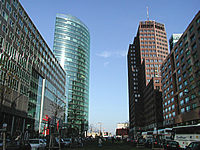 |
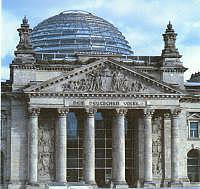 |
![]() The district of Tiergarten,
connecting the eastern and the western city centre, is rich in sightseeings and
institutions like hardly any other. The district's south is occupied by the
giant park which used to serve the upper nobility's hunting pleasure and
gave the district of Tiergarten ("animal garden") its name. Here you
meet in summer to lie in the meadow, barbecue and relax. Straße des 17. Juni
avenue, traversing the Tiergarten park, sets the scene for the city's biggest flea
market on its western end every weekend. Further eastwards you pass the Großer
Stern (big star) surmounted by one of the city's landmarks: the Siegessäule
(victory column), accessible from the inside and fondly called "Goldelse"
(golden Elsie) by the Berliners. Here, the final event of the Love Parade,
the world's biggest party, takes place every year. On the Tiergarten's southwest
fringe the Zoologic Garden is situated; Germany' oldest zoo is with its
19,000 animal species one of the world's most biodiverse. A few steps away from
Brandenburger Tor sits Bundestag parliament in the recasted Reichstag
building. The glass dome, designed by Sir Norman Foster, fills the dusky
Wilhelminian building with daylight and attracts thousands of visitors each day.
Since the Wall was torn down, Potsdamer Platz square has changed from
neglected wasteland to Berlin's new centre. Shops, restaurants, a casino and a
musical theatre allure Berliners and tourists just as the impressive tower block
architecture and the Sony Center. Anyway, film devotees won't get around
Potsdamer Platz due to the numerous cinemas, the film house and the hither
relocated "Berlinale" film festival. Lovers of art and culture will
find their place to be along Potsdamer Straße: chock-a-block, there are the Philharmonie
concert hall with its striking silhouette, home of the world-famous Berliner
Philharmoniker, the Staatsbibliothek library, the Neue Nationalgalerie,
presenting first-rank changing exhibitions in coolish, transparent architecture,
and the Kulturforum with the Gemäldegalerie, an incomparable
collection of masterpieces by Rubens, Rembrandt, Tizian and others. Following
the Potsdamer Straße across the Landwehrkanal channel you sure will encounter
the conspicuous facade of the Wintergarten variete. On the North of the
Tiergarten, between Haus der Kulturen der Welt (house of world's
cultures, better known as "pregnant oyster") and Akademie der Künste
(academy of fine arts) resides the Head of State, the Bundespräsident, in castle
Bellevue. Further to the North, across the Spree river, the old workmen's
quarter Moabit, not least known by its court and prison, is one of
Berlin's typical places. The cranes in the Spree arc witness the workings on the
new government quarter. Another building site is Lehrter Stadtbahnhof
station, neglected for decades due to its nearness to the Wall and now becoming
Berlin's central long-distance station. Hamburger Bahnhof transversely
across the street is an interesting museum of modern art.
The district of Tiergarten,
connecting the eastern and the western city centre, is rich in sightseeings and
institutions like hardly any other. The district's south is occupied by the
giant park which used to serve the upper nobility's hunting pleasure and
gave the district of Tiergarten ("animal garden") its name. Here you
meet in summer to lie in the meadow, barbecue and relax. Straße des 17. Juni
avenue, traversing the Tiergarten park, sets the scene for the city's biggest flea
market on its western end every weekend. Further eastwards you pass the Großer
Stern (big star) surmounted by one of the city's landmarks: the Siegessäule
(victory column), accessible from the inside and fondly called "Goldelse"
(golden Elsie) by the Berliners. Here, the final event of the Love Parade,
the world's biggest party, takes place every year. On the Tiergarten's southwest
fringe the Zoologic Garden is situated; Germany' oldest zoo is with its
19,000 animal species one of the world's most biodiverse. A few steps away from
Brandenburger Tor sits Bundestag parliament in the recasted Reichstag
building. The glass dome, designed by Sir Norman Foster, fills the dusky
Wilhelminian building with daylight and attracts thousands of visitors each day.
Since the Wall was torn down, Potsdamer Platz square has changed from
neglected wasteland to Berlin's new centre. Shops, restaurants, a casino and a
musical theatre allure Berliners and tourists just as the impressive tower block
architecture and the Sony Center. Anyway, film devotees won't get around
Potsdamer Platz due to the numerous cinemas, the film house and the hither
relocated "Berlinale" film festival. Lovers of art and culture will
find their place to be along Potsdamer Straße: chock-a-block, there are the Philharmonie
concert hall with its striking silhouette, home of the world-famous Berliner
Philharmoniker, the Staatsbibliothek library, the Neue Nationalgalerie,
presenting first-rank changing exhibitions in coolish, transparent architecture,
and the Kulturforum with the Gemäldegalerie, an incomparable
collection of masterpieces by Rubens, Rembrandt, Tizian and others. Following
the Potsdamer Straße across the Landwehrkanal channel you sure will encounter
the conspicuous facade of the Wintergarten variete. On the North of the
Tiergarten, between Haus der Kulturen der Welt (house of world's
cultures, better known as "pregnant oyster") and Akademie der Künste
(academy of fine arts) resides the Head of State, the Bundespräsident, in castle
Bellevue. Further to the North, across the Spree river, the old workmen's
quarter Moabit, not least known by its court and prison, is one of
Berlin's typical places. The cranes in the Spree arc witness the workings on the
new government quarter. Another building site is Lehrter Stadtbahnhof
station, neglected for decades due to its nearness to the Wall and now becoming
Berlin's central long-distance station. Hamburger Bahnhof transversely
across the street is an interesting museum of modern art.
Except of the west-east city-train axis (S3, S5, S7, S9), Tiergarten is connected by U9 underground to public transport net.
 |
 |

|
![]() While Unter den Linden
passes for the city's representative avenue, the Kurfürstendamm, shared
by Wilmersdorf and Charlottenburg,
stands for exclusive shopping, for nightlife, for cafes, theatre and chic
department stores, concisely: for urban lifestyle. Nowhere else in Berlin you
will find so many hotels and guest houses as on the "Kudamm" and its
byroads. A few steps south of this boulevard you have left the metropolitan
hectic behind and stroll through a bourgeois, partly exclusive
residential quarter in Wilhelminian style which nevertheless doesn't lack
restaurants and clubs. Fasanenplatz, Ludwigkirchplatz or Rüdesheimer
Platz squares with their relaxed street cafes, trees and fountains are
popular meeting points for the Berliners. In the Fasanenstraße, the
atmosphere becomes truly noble with its boutiques and galleries
. Many religions have left their traces in Wilmersdorf: the Moslems with the mosque
in the Brenner Straße, the Russian-Orthodox christians with the Christi-Auferstehungskirche
from the 1930s or the Jews with their parish hall in the Fasanenstraße,
to name only the most striking. In Wilmersdorf's West you by and by leave the
city centre to steep into Grunewald forest with its recreational areas
and its nature-sanctuaries. And what could be more relaxing after rambling over
Kudamm than a trip to Grunewald- or Hundekehlesee lake?
While Unter den Linden
passes for the city's representative avenue, the Kurfürstendamm, shared
by Wilmersdorf and Charlottenburg,
stands for exclusive shopping, for nightlife, for cafes, theatre and chic
department stores, concisely: for urban lifestyle. Nowhere else in Berlin you
will find so many hotels and guest houses as on the "Kudamm" and its
byroads. A few steps south of this boulevard you have left the metropolitan
hectic behind and stroll through a bourgeois, partly exclusive
residential quarter in Wilhelminian style which nevertheless doesn't lack
restaurants and clubs. Fasanenplatz, Ludwigkirchplatz or Rüdesheimer
Platz squares with their relaxed street cafes, trees and fountains are
popular meeting points for the Berliners. In the Fasanenstraße, the
atmosphere becomes truly noble with its boutiques and galleries
. Many religions have left their traces in Wilmersdorf: the Moslems with the mosque
in the Brenner Straße, the Russian-Orthodox christians with the Christi-Auferstehungskirche
from the 1930s or the Jews with their parish hall in the Fasanenstraße,
to name only the most striking. In Wilmersdorf's West you by and by leave the
city centre to steep into Grunewald forest with its recreational areas
and its nature-sanctuaries. And what could be more relaxing after rambling over
Kudamm than a trip to Grunewald- or Hundekehlesee lake?
U1, U7 and U9 underground lines are the most important public transport connections through Wilmersdorf. Traffic junctions like Zoo station or Westkreuz neighbour the district.
| Berlin Tourismus Marketing GmbH and the city of Berlin are looking forward to your visit! |
http://www.btm.de/english/index.html